by Lisa Cooke | Jan 9, 2017 | 01 What's New, DNA |
As genealogists, we spend our time trying to ferret out the real story in our family’s oral history, or at least from the records they left behind. Record research is critical, but now we have an amazing new tool…DNA matching.

Genealogists constantly check family stories against the information on records, searching for what sounds plausible and what doesn’t. Even when we have total agreement in our records, more information often comes along…like DNA testing. In fact, DNA matching may shed light on even more apparent discrepancies.
Family Lore vs. DNA Findings
I recently read an article in the Wall Street Journal about a reporter, Cameron McWhirter, who shared finding that kind of discrepancy between his family lore and his DNA. He even goes so far as to say, “I am descended, at least partially, from liars.” He makes the point, “many immigrants reinvented themselves when they arrived here (the United States).” This could be a nice way of saying they had a chance to invent a new legacy, not just re-invent it. His assessments were certainly interesting and worth reviewing. It helps us see how DNA testing can affect the way we look at our family stories and traditional research results.
McWhirter may be like some folks today who have never set foot inside a courthouse or scanned through microfilm, but instead relies heavily on internet research. Some of these modern genealogists never gave their family history a second thought until, like McWhirter, the death of parents started to inspire them to dig deeper. Due to the large volume of information online, the budding genealogist is “quickly pulled into the obsessive world of modern genealogical research.”

Example of an ethnicity report from Ancestry.com.
McWhirter’s personal story was that while his dad was proudly and solidly a self-proclaimed Scot, the records and DNA matching revealed his heritage was actually from Ireland and eastern Europe. McWhirter says that his “father hated Notre Dame, but judging by my results he could have been one-quarter to one-half Irish. He spoke dismissively of people from Eastern Europe, but part of his genetic code likely came from that region.”
McWhirter’s evaluation of his genetic report includes only his ethnicity results, which as you can hear, were meaningful to him in the way that flew in the face of his father’s prejudices and assertions of his own identity.
However, the ethnicity results fall short of the point of testing for most genealogists.
He has the opportunity to more powerfully transform his sense of family identity by taking a look at his match list. Here, he may see an actual living cousin who was also descended from his German great-grandmother, who maybe never mentioned that she was also Jewish.
The Real Goal: DNA Connections to Living Family
Connecting with other cousins who also have paper trails to our ancestors serves to provide further confidence that we have put all the pieces together and honored the right ancestor with a spot on our pedigree chart. We multiply our own research efforts by finding more people like us—literally—who are descended from the same people. As long as they are as diligent in their research as we are, we can make these connections that could finally bust through those genealogy brick walls and more.
At a recent conference, I met a fifth-cousin. Even with a connection that distant, it was exciting and it encouraged us to want to look again at our connecting ancestors. To me, that is the bigger picture and the real goal—when the paper trail comes together with the DNA results and turns into real live cousins.
The Next Step: Using Your DNA Results to Find Living Family
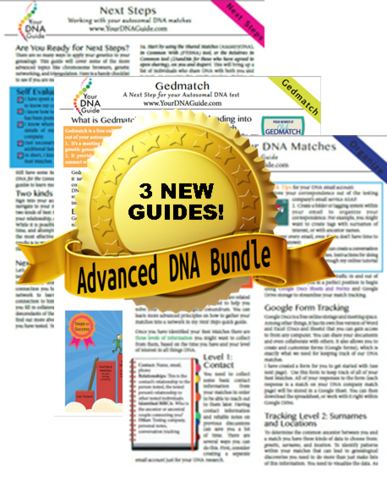 Maybe you are like Cameron McWhirter: you’ve taken a DNA test, been intrigued or disappointed by the ethnicity results, but haven’t fully explored your matches on your list. You may be seriously missing some opportunities! If that is you, I have written my new DNA quick guide just for you. It’s called “Next Steps: Working with Your Autosomal DNA Matches.” This guide will teach you how to leverage the power of known relatives who have been tested. You will get an intro to chromosome browsers and their role in the search process and access to a free bonus template for evaluating genealogical relationship of a match to the predicted genetic relationship. This guide also gives you a methodology for converting unknown relatives on your match list into known relatives.
Maybe you are like Cameron McWhirter: you’ve taken a DNA test, been intrigued or disappointed by the ethnicity results, but haven’t fully explored your matches on your list. You may be seriously missing some opportunities! If that is you, I have written my new DNA quick guide just for you. It’s called “Next Steps: Working with Your Autosomal DNA Matches.” This guide will teach you how to leverage the power of known relatives who have been tested. You will get an intro to chromosome browsers and their role in the search process and access to a free bonus template for evaluating genealogical relationship of a match to the predicted genetic relationship. This guide also gives you a methodology for converting unknown relatives on your match list into known relatives.
So check it out, either by itself or as part of my Advanced DNA bundle, which comes along with my new Gedmatch guide and a guide expressly for organizing your DNA matches.
by Lacey Cooke | Dec 3, 2018 | 01 What's New, Ancestry, DNA |
Get a new perspective on your DNA results with AncestryDNA’s new Genetic Traits feature. For just $10, you can discover how traits run in your family and might even come from ethnic origins, with no additional DNA test needed. It’s a deeper look into what...
by Lisa Cooke | Jun 16, 2016 | 01 What's New, Records & databases
 Here’s this week’s group of new genealogy records online. Though not all these databases are new, many have been updated and are definitely worth another look! Records for: England, Ireland, Australia, and the United States.
Here’s this week’s group of new genealogy records online. Though not all these databases are new, many have been updated and are definitely worth another look! Records for: England, Ireland, Australia, and the United States.
ENGLAND – WARWICKSHIRE – BURIALS. Warwickshire Burials, 1836-2006 at Findmypast now has over 175,000 new records. This collection contains more than 1 million records which include inscriptions from the Clifton Road Cemetery in Rugby.
ENGLAND – SURREY – MARRIAGE. New records have been added to the Surrey Marriage Index, 1538-1887 on Findmypast. Though it is only an index, it now offers over 755,000 records from 178 parishes in Surrey, England.
IRELAND – COURT REGISTERS. Findmypast has added Irish Petty Sessions Court Registers, 1828-1912 to their collections. This database includes details of victims and witnesses, as well as those accused of a crime. The Petty Sessions were the lowest courts and often heard cases about money and domestic disputes. Another exclusive database for Ireland research is the Ireland Poor Law Reports, also found at Findmypast.
AUSTRALIA – BEACHPORT – RATE BOOKS. South Australia Rate Books is an index of about 4,000 records. This index was transcribed from rate assessments for the coastal district of Beachport between the years of 1882 and 1888. Information varies, but may include your ancestor’s name, assessment year, assessment number, occupier, owner, situation, and town.
UNITED STATES – HOMESTEAD RECORDS. Ancestry.com has updated their U.S., Homestead Records, 1861-1936 this week. These records currently only cover six states, which are: Ohio, Arizona, Indiana, Iowa, Nebraska, and Nevada. They will be adding more states in the future. These documents are part of the Records of the Bureau of Land Management. Many application and case files contain valuable pieces of genealogical data.
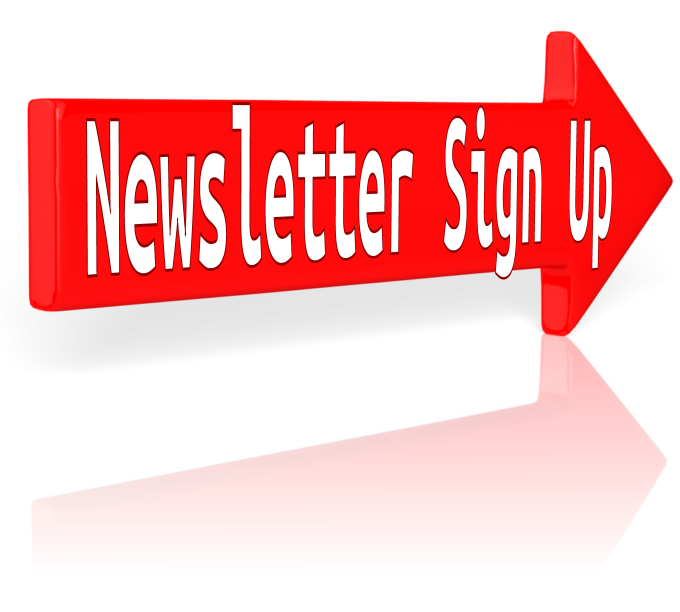
Be sure to check in next week to see what’s new in genealogy records and collections. Sign-up for Lisa’s free weekly e-newsletter so you are sure not to miss it. Just enter your email address in the sign-up box at the top of this webpage or scroll to the bottom if you are on your mobile device. You’ll also receive a free e-book with Lisa Louise Cooke’s best Google search strategies for genealogists!
by Lisa Cooke | Jun 9, 2017 | 01 What's New, Craft & Displays, DNA, Gifts
Just in time for Father’s Day! This new DNA ethnicity chart design is a classy and cutting-edge way to share your family history. As wall displays, this is the perfect conversation-starter for your home or heritage gift for a loved one.
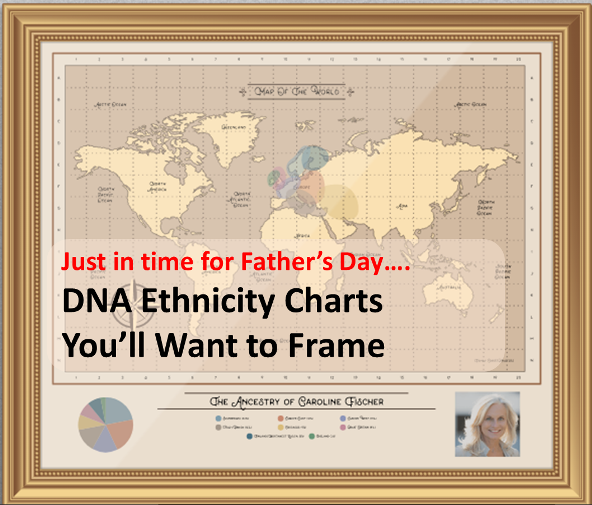
There’s a gorgeous new way to display your genetic genealogy from Family ChartMasters! It’s a new custom DNA ethnicity chart, and it’s a fantastic way to spark conversation about your family history with friends and loved ones.
“At Family ChartMasters we believe that family history can save the world,” says owner Janet Hovorka. “The more people know about their background, the more they are inspired with civility, gratitude and compassion for other people because they find out we are all more alike than different. We want to help people make that easy to remember every day.”
Your ethnic “pie chart”
 DNA ethnicity results–those “pie charts” that come with your genetic genealogy test results–are one of the most popular aspects of testing. Even those without an active interest in researching their roots often test just to learn what their DNA says about their genetic roots: How Irish are they? Do they have Jewish roots? Is there any truth to that old family story about being descended from an Indian princess?
DNA ethnicity results–those “pie charts” that come with your genetic genealogy test results–are one of the most popular aspects of testing. Even those without an active interest in researching their roots often test just to learn what their DNA says about their genetic roots: How Irish are they? Do they have Jewish roots? Is there any truth to that old family story about being descended from an Indian princess?
The science behind DNA ethnicity percentages is still being refined, as is evident from the varying ethnicity results you may receive from different companies. But it’s still fascinating to learn–and super shareable with just about anyone!
DNA ethnicity chart options
Family ChartMaster’s new DNA ethnicity chart comes in three themes to fit a variety of different décor styles: Basic, Antique, and Modern. The Basic theme is clean and fresh, and complements most decorating styles. The Antique theme’s sepia-tone finish brings together the styling of antique maps with your high-tech DNA profile. The Modern theme is graphic and bold, with neutral tones well-suited to contemporary décor.
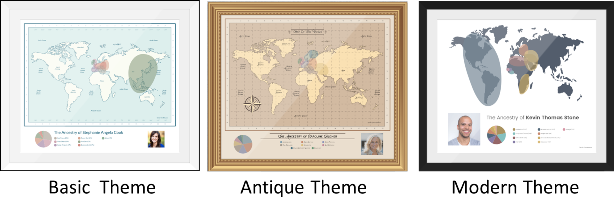
In less than five minutes, you can upload an optional photo and then manually enter your ethnicity estimates from a DNA test. The categories are currently aligned with AncestryDNA’s ethnic regions–which is running a great sale for Father’s Day, by the way, if you’ve been waiting to purchase a test. (Other DNA test providers also have some great prices now; click here to see them.)
After viewing a preview of your DNA ethnicity chart, you can place an order that can be printed on archival Professional Paper or Artist’s Grade Canvas. Following Family ChartMasters’ proven track record of superior service, the beautiful print will arrive rolled in a tube and ready to frame. You can also order PDF downloads for immediate delivery to an email inbox. Pricing starts at $19.95.
(Will your chart come in time for Father’s Day? According to the Family ChartMasters website, orders take 24-48 hours to prepare, and regular shipping takes 2-3 days within the U.S. Faster shipping options are available for an additional charge. If in doubt, order the PDF download.)
These DNA ethnicity charts are perhaps the easiest heritage display you’ll ever make! They also take advantage of the current widespread interest in DNA, making a conversation about your heritage more meaningful and appealing even with those who have never expressed interest in your heritage. Click here to see how to order your DNA ethnicity chart.
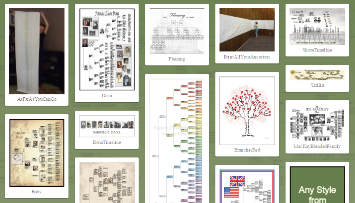 More than DNA charts: Family ChartMasters is an award-winning genealogy chart printing and design service. It is also the official printing service for most worldwide genealogy software, database, and research companies. Family ChartMasters prints any style of family history chart from any kind of file. They offer oversized draft-quality family reunion charts as well as custom decorative designs.
More than DNA charts: Family ChartMasters is an award-winning genealogy chart printing and design service. It is also the official printing service for most worldwide genealogy software, database, and research companies. Family ChartMasters prints any style of family history chart from any kind of file. They offer oversized draft-quality family reunion charts as well as custom decorative designs.
 Click below to read more about….
Click below to read more about….
Getting your DNA tested (or someone else’s)
Creating beautiful and unique heritage displays


 Maybe you are like Cameron McWhirter: you’ve taken a DNA test, been intrigued or disappointed by the ethnicity results, but haven’t fully explored your matches on your list. You may be seriously missing some opportunities! If that is you, I have written my new DNA quick guide just for you. It’s called “Next Steps: Working with Your Autosomal DNA Matches.” This guide will teach you how to leverage the power of known relatives who have been tested. You will get an intro to chromosome browsers and their role in the search process and access to a free bonus template for evaluating genealogical relationship of a match to the predicted genetic relationship. This guide also gives you a methodology for converting unknown relatives on your match list into known relatives.
Maybe you are like Cameron McWhirter: you’ve taken a DNA test, been intrigued or disappointed by the ethnicity results, but haven’t fully explored your matches on your list. You may be seriously missing some opportunities! If that is you, I have written my new DNA quick guide just for you. It’s called “Next Steps: Working with Your Autosomal DNA Matches.” This guide will teach you how to leverage the power of known relatives who have been tested. You will get an intro to chromosome browsers and their role in the search process and access to a free bonus template for evaluating genealogical relationship of a match to the predicted genetic relationship. This guide also gives you a methodology for converting unknown relatives on your match list into known relatives.
 Here’s this week’s group of new genealogy records online. Though not all these databases are new, many have been updated and are definitely worth another look! Records for: England, Ireland, Australia, and the United States.
Here’s this week’s group of new genealogy records online. Though not all these databases are new, many have been updated and are definitely worth another look! Records for: England, Ireland, Australia, and the United States.

 DNA ethnicity results–those “pie charts” that come with your genetic genealogy test results–are one of the most popular aspects of testing. Even those without an active interest in researching their roots often test just to learn what their DNA says about their genetic roots: How Irish are they? Do they have Jewish roots? Is there any truth to that old family story about being descended from an Indian princess?
DNA ethnicity results–those “pie charts” that come with your genetic genealogy test results–are one of the most popular aspects of testing. Even those without an active interest in researching their roots often test just to learn what their DNA says about their genetic roots: How Irish are they? Do they have Jewish roots? Is there any truth to that old family story about being descended from an Indian princess?

 Click below to read more about….
Click below to read more about….